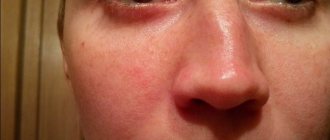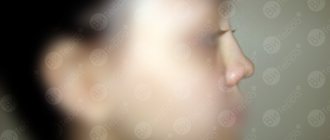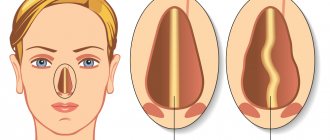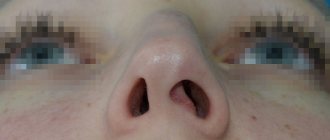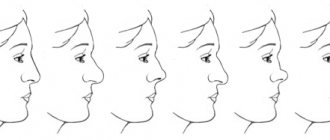Septoplasty is an operation to correct the nasal septum. The need to straighten the septum is due not only to external defects, but also to possible health consequences.
The osteochondral plate is a formation that forms the nasal septum. When examining most patients, you can notice deviated septum from minor to very significant. Only a small part of people have its ideal form.
The most common causes of a deviated nasal septum:
- Physiological. Due to the rapid growth of the young organism, the nasal plate is deformed. One of its tissues (for example, cartilage) is ahead of bone. Lack of space causes the nasal septum to deviate to one side. At the border of the bend, various formations appear: ridges, cartilaginous parts, chips.
- Compensatory. The plate is displaced due to the pressure on it from polyps and hypertrophied nasal turbinates. Restoration is necessary if there is a significant defect.
- Traumatic. Fractures and bruises lead to deviated septum. They pose the greatest danger in childhood and adolescence. In such cases, the nasal septum should be straightened as soon as possible.
The type of curvature does not affect the complexity of the operation, its cost, or the recovery period.
What is septoplasty
Septoplasty
- surgery to correct a deviated nasal septum. Deviation can develop during the growth of the bone and cartilaginous parts of the nasal septum and as a result of trauma to the nose.
When breathing through the nose, the air in the nasal cavity is moistened, warmed, and disinfected (the mucus produced by the cells of the nasal mucosa has a bactericidal effect). Small villi - cilia of the ciliated epithelium on the nasal mucosa ensure the removal of various biologically active agents: bacteria, viruses, toxins. Thus, humidified, warmed, and disinfected air enters the lower respiratory tract and the cavity of the paranasal sinuses. When the nasal septum is deviated, these functions may be impaired due to improper passage of the air stream.
Possibilities of septoplasty in aesthetic correction of the nose.
Violations of the internal structures of the nose inevitably lead to external deformations, disrupting the aesthetics of the nose and the entire face. Let's consider what problems can be solved by combining septoplasty and rhinoplasty in a clinic in Moscow.
In rhinoplasty, it is customary to take into account the so-called “tripod” principle, which gives understanding and predictability of the directions in which the tip of the nose moves depending on the position of its internal structures. In this case, correctly performed septoplasty - correction of the nasal septum - can eliminate the following possible deformities of the external nose.
A too short nasal septum causes the tip of the nose to droop, the columella to retract and reduce the projection of the nose. In this case, septoplatia, as well as the use of grafts (special nasal implants), allows you to create the desired length and shape of the nasal septum, thereby creating the correct support for all nasal structures.
An excessively protruding part of the nasal septum causes the tip of the nose to tend upward, creates an excessive projection of the tip of the nose, the level of the back of the nose and its tip have too large a difference, as a result of which a so-called saddle-shaped deformation of the nose may exist. Septoplasty (in this case, shortening of the nasal septum) will help change the position of the tip of the nose.
Septoplasty, in the case of shortening the nasal septum to change the position of the nasal tip without corresponding additional correction of the cartilage of the nasal wings, can lead to the fact that the tip of the nose becomes flat, undesirably wide and loses its shape.
If the patient is not satisfied with the overall appearance of his external nose, then septoplasty can be successfully combined with aesthetic rhinoplasty.
Indications for surgical treatment
Indications for surgery:
- difficulty breathing through the nose
- development of chronic rhinitis
- recurrent purulent sinusitis
- recurrent nosebleeds (if the cause of the bleeding is a deviated nasal septum). When an air stream hits a curvature, irritation and atrophy of the mucous membrane gradually develops in this area.
- development of cysts in the paranasal sinuses
- development of polypous processes in the sinuses (treatment is necessary to eliminate the mechanical barrier to the passage of medicinal substances into the sinuses)
To determine whether surgical treatment is required in your case, the doctor will conduct instrumental studies (endoscopic examination of the nasal cavity, computed tomography of the paranasal sinuses) to exclude pathology, as well as laboratory research methods to exclude the allergic and infectious nature of difficulty in nasal breathing.
Indications for surgery to correct (align) the nasal septum
Surgical correction of the septum is resorted to in the following cases:
- narrowing of the nasal passage in one or both parts;
- air permeability difficulties;
- formation of pathological vortices.
Such processes provoke excessive dryness of the inner membrane, atrophic changes, covering the openings of the sinuses and auditory tube. Such changes should be corrected as early as possible, as they disrupt free air exchange and prevent the outflow of secretions from the sinuses and tympanic cavity.
The patient receives a referral for recovery using surgery in the absence or significant difficulty breathing through the organ, chronic or frequent acute otitis.
Corrective surgery is often performed in case of unsuccessful long-term treatment of pathologies such as vasomotor rhinitis, hypertrophied turbinates, and polyposis.
Types of septoplasty
Radio wave septoplasty
Radio wave septoplasty
– the most gentle type of surgical intervention, since the excision occurs in the nasal cavity on the mucous membrane, thanks to this it becomes possible to avoid scars. The advantages of the operation are not only aesthetics, but also the fact that the postoperative period takes less time. In terms of time, radio wave septoplasty takes no more than one hour along with preparation for the operation. During septoplasty, the surgeon removes only those parts of the nasal tissue that do not allow the nasal cavity to function normally, so in most cases the integrity of the nasal septum remains unchanged.
Laser septoplasty
Laser septoplasty
performed by equipment that creates a laser beam.
This type of operation produces a great antiseptic effect, so the likelihood of infection or complications during and after the operation is as low as possible. The rehabilitation period passes quite quickly. Laser septoplasty takes no more than half an hour, and hospital stay is no more than a day. But with all the advantages of this procedure, it has a large list of contraindications. You should consult your doctor. Comparative characteristics of radio wave and laser septoplasty
| Radio wave septoplasty | Laser septoplasty | |
| What is used | Surgitron device Videoendoscope | Laser ray Video endoscope |
| Operation duration | Within an hour (depending on the complexity of the curvature). | No more than half an hour |
| pros | The most gentle method Avoiding scars (only curved sections of the septum are removed, the curved cartilage is corrected and returned to its place in a corrected form). Maintaining the integrity of the septum Short rehabilitation period | Great antiseptic effect Short rehabilitation period Short operation time Shortest duration of hospital stay in the postoperative period Shortest duration of hospital stay in the postoperative period (1 day). |
| Minuses | Longer hospital stay | Correction of curvature using a laser is only possible in the cartilaginous part of the nasal septum. Therefore, the method is used much less frequently. Multiple contraindications. |
| Staying in hospital | 3 days | 1 day |
Operation to straighten the nasal septum: preparation and implementation
Before surgery to correct the nasal septum, the specialist prescribes examinations for the patient that should be carried out:
Analyzes
- general blood analysis*;
- general urine analysis*;
- biochemical blood parameters*;
- determination of blood clotting*;
- electrocardiogram (ECG);
- dental examination;
- therapist's report
*At the Federal Scientific and Clinical Center FMBA, blood tests, urine tests and biochemical blood parameters can be taken until 10 a.m. every day; no appointment is required.
Before surgery to correct the nasal septum, drugs that can cause bleeding are excluded - aspirin, anti-inflammatory drugs, warfarin.
The procedure necessarily includes pain relief. This can be local or general anesthesia, as agreed with the patient. The specialist gains access through the nasal cavity; the operation does not involve external incisions.
Correction by surgery lasts from 0.5 to 1.5 hours. After the operation, the surgeon inserts tampons into the nose for 1-2 days, which can cause some physical and aesthetic discomfort.
How is the operation performed?
The goal of surgical treatment is to remove the cartilaginous and bone deviated parts of the nasal septum. The curved sections of the cartilage are further remodeled, as a result of which they become straight and, in this form, are re-implanted back between the layers of the mucous membrane.
During the operation, our clinic uses the Surgitron radio wave apparatus to reduce tissue bleeding.
If there is a curvature only in the area of the cartilaginous part of the nasal septum, the operation can be performed using a laser.
The advantage of the operation in our clinic is the least trauma to tissues, removal of only the curved parts of the nasal septum, and reimplantation of the corrected sections of cartilage back.
Who needs surgery
A deviated septum can occur due to traumatic, physiological, or compensatory problems. Conservative drug treatment alleviates symptoms, but does not solve the cause of its occurrence. The operation is possible if there are no contraindications such as diabetes, cardiovascular, oncological or infectious diseases. In addition, at the time of the operation, the patient should not have acute respiratory viral infections or acute respiratory infections.
Patients should undergo surgery if they have the following symptoms:
- there are cosmetic defects - curvature, hump, depression;
- breathing is difficult;
- decreased sense of smell;
- frequent congestion appears;
- you constantly feel dry in the nasopharynx;
- during sleep, breathing is accompanied by snoring;
- frequent headaches and nasal bleeding occur;
- decreased attention, memory and performance;
- respiratory allergies appear.
In this case, the listed signs are identified in a complex, and the need for surgical correction of the curvature is decided jointly by the patient and the otolaryngologist after examination, including with the help of an endoscope.
In some cases, surgery is done for other health problems. Thus, correcting the septum in the nose for people with bronchial disease (for example, asthma) provides more complete functioning of the respiratory system.
Risks
Swelling, hematoma (bruising) and soreness are normal after surgical correction of the nasal septum. They go away after 2–3 weeks.
If the doctor correctly assessed the patient’s condition and took into account contraindications, the risk of serious complications tends to zero. However, the surgeon must tell each patient in advance about the possible consequences:
- Perforation (through hole) of the nasal septum. The cause is almost always surgical errors, and this problem can only be eliminated with a repeat operation.
- Bleeding may occur in the first days after the intervention. You should try to stop it with a tampon and consult a doctor immediately.
- Scarring. The likelihood of severe scars after septoplasty depends on the skill of the surgeon and the characteristics of the patient’s body. If the scar does not interfere with anything, it can be left alone. Otherwise, it must be excised.
- Decreased sensitivity. A very rare complication. Occurs when the surgeon accidentally damages the nerves.
The international clinic Medica24 employs experienced, highly qualified otolaryngologist surgeons. We use the most modern equipment during operations. Before surgery, our doctors carefully assess each patient’s condition and possible risks.
We will call you back, leave your phone number
Message sent!
expect a call, we will contact you shortly
Postoperative period
The next day, the operating surgeon examines you and performs the “nasal toilet” procedure, which consists of lubricating the nasal cavity with medications and aspiration (suction) of accumulated mucus and ichor from the nasal cavity. This procedure will significantly improve nasal breathing; upon discharge you will be given a list of recommendations and everything will be explained in detail for each item.
To further reduce the likelihood of complications, you will need to take precautions for 2-3 weeks.
What types of rhinoplasty are there?
Rhinoplasty in Moscow is a popular and frequently performed operation that brings positive results and makes women more beautiful and attractive. In surgery, there are three types of rhinoplasty.
Open
In this case, the doctor makes small incisions next to the septum near its narrow part, then separates the skin and corrects the shape of the nose, removes excess cartilage and makes sutures. A plaster bandage or splint made of synthetic materials is applied to the nose, and a cotton swab is inserted into each nostril until the next dressing.
First, two cuts are made. One is near the columella, the tissue that separates the two nostrils. In this case, a retractor is used, which helps to open the inside of the nose wider, then the next incision is made - the marginal one, it runs next to the first incision - from the columella to the nostrils. Using surgical scissors, the doctor makes a small incision in the skin and separates it from the frame, after which other parts of the nose are dissected, which makes it possible to make the exact shape of the nose and carry out its correction.
Closed
During the operation, internal incisions are made to the patient, as a result of which the scars will not be noticeable. Each incision is closed with internal sutures made from self-absorbing threads. Closed rhinoplasty differs from open rhinoplasty in that the skin is not separated from the frame with surgical instruments, but part of the bone, cartilage and tissue can be removed. For some plastic surgeons, this method is the most effective because the rehabilitation period is minimal and results can be seen faster.
Reviews about rhinoplasty in Moscow are on our website. Photos of rhinoplasty of the nose are also posted here.
Non-surgical rhinoplasty - reviews that speak for themselves
During this procedure, the shape of the nose is changed with injectable preparations with hyaluronic acid, or with the help of fatty tissue, which is taken from some other part of the body.
When using fillers, the doctor must give directions for tests, get acquainted with the characteristics of your health, and hold a conversation during which he will select the drugs that are suitable for you personally. The patient must undergo a test to determine the presence or absence of allergic reactions to drugs.
Preparing for surgery
Although the risk of infection during laser septoplasty is minimal, the patient will have to undergo examination to identify contraindications, diseases and pathologies.
List of preparatory tests:
- Blood test for HIV infection, hepatitis B and C, syphilis, coagulation, biochemistry, blood group and Rh factor.
- Analysis of urine.
- Research on oncological diseases, tumors.
- Checking blood pressure.
- Fluorography.
- External examination by an otolaryngologist.
- Hardware examination (includes radiography, computed tomography, endoscopic examination).
According to doctors, pathology of the nasal septum occurs in half of the population . The causes of deformation include both congenital pathologies and injuries, bruises, and fractures.
In some cases, the curvature does not interfere with life in any way, and the person does not even know about the unevenness of the septum.
During the period of preparation for surgery, doctors recommend giving up alcoholic beverages and cigarettes and not catching a cold.
How I do laser surgery on the nasal septum (laser septochondrocorrection)
Otolaryngologist for adults and children
Manevich
Igor Semenovich
25 years of experience
Otorhinolaryngologist of the highest category, member of the European Rhinologic Society
Make an appointment
Difficulty in nasal breathing can lead to the development of pathological conditions in the pharynx, trachea, bronchi, and lungs. In childhood, as a result of inadequate nasal breathing, a number of disturbances in physical and mental development occur. Therefore, today we will talk about the most effective method for treating such difficulties today.
In addition, with the development of pathology in the nasal cavity, the sense of smell is impaired, the voice changes, headaches and depression occur, in a word, the quality of a person’s life is significantly reduced. It’s not for nothing that otolaryngologists say: “How well the nose “works”, so well does the whole body live.”
The main cause of difficulty in nasal breathing is deformation of the nasal septum, which occurs as a result of injury or improper development during the period of growth of the body (hereditary factor). As a result, chronic rhinitis and difficulty in nasal breathing develop, up to its complete absence! Naturally, with such prospects, even the laziest person will run to the doctor - but what awaits him there? A very unpleasant surgical operation that is quite “bloody” and painful. No one will like such an intervention, but it is necessary - after all, nasal breathing must be restored. Therefore, the path for a person with a deformed nasal septum usually leads to a difficult but necessary decision: surgery.
Deformed and normal nasal septum
The surgical method for correcting a deformed nasal septum is called septoplasty, and it has a number of significant disadvantages. First, it is an operation that uses a tool such as a chisel. I think there is no need to explain how it is used - the deformed parts of the septum are removed, then sometimes a transplant is used to give it hardness. After the operation is completed, the patient's mucous membrane covering the nasal septum is tightly compressed with tampons for several days. This is followed by several days of hospital stay. Needless to say, such an operation requires expensive and not at all useful anesthesia, that during the rehabilitation period the patient will be deprived of the opportunity to work normally, and that, unfortunately, numerous unpleasant complications are possible - in short, this is far from an ideal method of treatment. It was necessary to come up with something new, and this was done by people whom I personally met (Prof. E.N. Sobolev and Prof. Helidonis).
The new method is called laser septochondrocorrection, and it simply eliminates most of the problems associated with the traditional surgical method of treatment. How does he work? First, to better understand the principle, try bending your ear with your fingers. As soon as you release it, it will return to its original shape. This occurs due to internal mechanical stresses in the cartilage, which fix its shape. After all, the ear is also cartilage, only covered with skin. So, by influencing the cartilaginous part of the nasal septum, you can force it to change its shape. But how?
Now it is possible to change the shape of cartilage using well-controlled, short-term laser heating, during which there is no time for tissue damage to occur, and mechanical stress is significantly reduced. To do this, I use a special laser machine, which I use to carry out this procedure in just 10 minutes!
These operations quickly gained popularity - of course, because they are cheaper, performed on an outpatient basis, do not entail hospitalization, are not associated with painful sensations, and are much easier to tolerate, if only they could be performed on everyone in need! Look at the title photo of the post - it shows the actual progress of the operation. Compare with a surgical intervention: a person under anesthesia, bloody tampons... Now it’s clear why more and more people want to be treated with a laser?
If in Greece, over 10 years of using the method, about 120 operations were performed, and in Russia - 200, then in our clinic in just six months we have already performed more than 90 operations, two yesterday alone, and today I will perform another one. It’s no wonder who would want to have a chisel wielded in their nose when they can take an hour off from work and restore their breathing quickly and painlessly.
If you have any questions, write in the comments, I will try to answer everyone!
Rehabilitation
The duration of rehabilitation after surgery usually takes a maximum of 1-2 weeks. During the first week, it is recommended to sleep on high pillows to minimize post-operative swelling.
Also, during this time you need to avoid bending, physical activity, and overheating the body. Healing is accelerated by using cold compresses (not wet, but made from chilled cereal). There are also hardware techniques that speed up the recovery period after nasal septum surgery.
Planning the operation
The planning stage is a very important stage; if carried out correctly, you can only expect successful results after the operation. During planning, the doctor uses modern technologies, selects the necessary form for each patient individually, so that after the rehabilitation period he looks perfect.
You can hope for the best result from a doctor of the highest category, Lelikov Kirill Slavovich; during a conversation with a potential client, he clarifies the characteristics of his body, selects a method of intervention, which, of course, is impossible without in-depth knowledge of anatomy, physiology and aesthetic taste. The price for rhinoplasty in Moscow from a doctor may differ in the volume of work or the type of plastic surgery used. Also, the doctor, after looking at the area of work, can offer non-surgical rhinoplasty.
Expected results
After endoscopic septoplasty, on the first day, patients feel some nasal congestion, similar to a common runny nose. But in the future, nasal breathing improves every day, and it is necessary to irrigate the nasal cavity with saline solutions. For 3-4 weeks, the patient is under observation, visiting the operating surgeon 1-2 times a week to adjust postoperative prescriptions and perform the procedure - toilet of the nasal cavity.
Restoration and normalization of nasal breathing occurs 21-28 days after endoscopic septoplasty.
Sign up for a consultation
The structure of the nasal septum, its significance
The nasal septum consists of two parts. The movable anterior part contains quadrangular cartilage. The fixed posterior one is the vomer and the perpendicular plate of the ethmoid bone. The upper edge forms the bridge of the nose.
The septum vertically divides the nasal cavity into two autonomous parts, which allows:
- determine the direction of the odor source;
- finely distinguish aromas (by increasing the area on which sensitive olfactory hairs are located);
- distribute air flows, give them the desired direction for further cleansing and warming.
Prices for septoplasty
Operation
Price
Septoplasty (nasal septum correction)
from 180,000 rub.
Attention! Professor Blokhin does not perform septoplasty or rhinoplasty. These operations are performed by other surgeons at the clinic.
Laser rhinoplasty
Nowadays, lasers are used in ophthalmology, orthopedics, ENT surgery, diagnostics and cosmetology. Its use allows you to cut, stitch, and remove tissue in places inaccessible to any other tool. Carry out the operation quickly and bloodlessly. Thereby reducing risks, recovery time, cost, and creating comfort and convenience for the patient.
Today we will talk about the use of laser in RHINOPLASTY, more precisely in plastic surgery of the nasal septum - SEPTOPLASTY.
The essence of the laser rhinoseptoplasty procedure
Problems with nasal breathing are associated with a deviated nasal septum or with excessive development of the turbinates, structures of the inner nose responsible for warming and purifying inhaled air. If a crooked septum is a consequence of trauma or congenital deformation, then hypertrophied nasal turbinates are exclusively a consequence of an aggressive environment. Regardless of the underlying causes, we have excess cartilage, bone or mucous tissue inside the nose. A laser beam is used to remove it. Under the control of an endoscope, the beam burns or vaporizes excess tissue. The lumen is cleared and breathing becomes free.
Lasers are different. In surgery, it is common to use a CO2 or carbon dioxide laser with a wavelength of about 10 microns. Such a laser has the necessary energy and sufficient depth of thermal action to vaporize tissue and stop bleeding.
Open rhinoplasty
Closed rhinoplasty
What can be done with a laser in the nose?
- remove the curved part of the nasal septum - remove the excess part of the nasal turbinates - remove excess bone fragments in the nasal septum and in the turbinates - stop bleeding - treat the ulcer inside the nasal passage - cause coagulation and removal of polyps - removal of tumors and formations
Why is laser not always used in rhinosurgery?
The most important reason is due to its high cost. A scalpel, tweezers, and a surgeon's salary cannot be compared with the cost of a surgical laser. The price of the latter can reach tens and hundreds of thousands of dollars. Its acquisition is justified when the number of such operations amounts to hundreds per year. An ordinary outpatient clinic or clinic can successfully manage without it, but sends complex cases to a specialized institution.
What are the advantages of laser in nose surgery over conventional methods?
The history of surgery suggests that before the advent of lasers in medicine, surgical problems were also successfully solved. The laser, of course, made it easier to remove tumors and evaporate tissue in hard-to-reach places in the nasopharynx, but it did not become a panacea for all diseases. Everything that can be done with a laser can be done using conventional methods. Therefore, when a patient focuses only on laser correction of the septum or, in general, on laser surgery, then his aspiration is a consequence of insufficient understanding of this method.
Most rhinologists use traditional methods, leaving laser room for marketing and increasing the cost of services.
Laser in aesthetic rhinoplasty
It must be emphasized right away that the main problems of rhinoplasty cannot be solved using a laser. Raising the tip of the nose, narrowing it, removing the nasal hump, asymmetry and others require a traditional general surgical approach. Advertising and promises of non-surgical rhinoplasty are false or deceptive. This applies to all other non-surgical rhinoplasties combined.
Laser in rehabilitation after nose surgery
After rhinoplasty there are inevitable consequences of injury. This is always swelling, possible bruising, compaction and discomfort. All these consequences disappear on their own within 1-2 weeks, and finally by 2-3 months. No measures can change the timing of normal recovery after rhinoplasty. In cases where complications arise and swelling does not go away within the usual time frame, we recommend physical therapy. The main activities are ultrasound, lymphatic drainage, massage, ultrasonic massage, regular massage. Laser effects may have a magical effect, but they are not included in the list of our recommendations.
LASER RHINOPLASTY – RESULT
Laser rhinoplasty is a marketing offer, deceit or deliberate misleading of the patient, which has no scientific or practical basis.
Rhinoplasty can be traditional, minimally invasive, endoscopic, open or closed, primary or revision, but cannot be laser. Septoplasty can be performed using a laser, but it does not have all the capabilities that conventional surgery has. That is, the laser is only an assistant or an additional tool in rhinosurgery.




